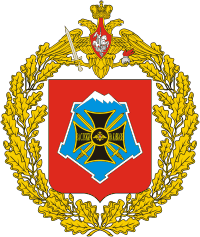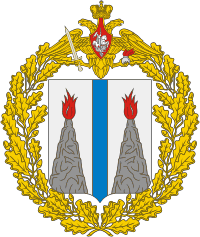
The Western Group of Forces (WGF), previously known as the Group of Soviet Occupation Forces in Germany (GSOFG) and the Group of Soviet Forces in Germany (GSFG), were the troops of the Soviet Army in East Germany. The Group of Soviet Occupation Forces in Germany was formed after the end of World War II in Europe from units of the 1st and 2nd Belorussian Fronts. The group helped suppress the East German uprising of 1953. After the end of occupation functions in 1954 the group was renamed the Group of Soviet Forces in Germany. The group represented Soviet interests in East Germany during the Cold War. Before changes in Soviet foreign policy during the early 1990s, the group shifted to a more offensive role and in 1989 became the Western Group of Forces. Russian forces remained in the eastern part of Germany after the dissolution of the Soviet Union and German reunification until 1994.

The Order of Lenin Leningrad Military District is a military district of the Armed Forces of the Russian Federation. The district was awarded the Order of Lenin in 1968. In 2010, it was merged with the Moscow Military District, the Northern Fleet and the Baltic Fleet to form the new Western Military District. In December 2022, Defense Minister Sergey Shoigu proposed to reestablish it along with the Moscow Military District, a decision confirmed in June 2023 by Deputy Chief of the General Staff Yevgeny Burdinsky. On December 17, 2023, Russian President Vladimir Putin announced plans to recreate the Leningrad Military District as a reaction to Finland joining NATO. The district was formally reconstituted on 26 February 2024 by a Presidential Decree No.141, transferring the Northern Fleet under its command.

The North Caucasus Military District was a military district of the Russian Armed Forces from 1992-2010. Before 1992 it had been part of the Soviet Armed Forces since 1918. In 2010 it became the Southern Military District and lately also included the Black Sea Fleet and Caspian Flotilla.

The Red BannerCarpathian Military District was a military district of the Soviet Armed Forces during the Cold War and subsequently of the Armed Forces of Ukraine during the early Post-Soviet period.

The Far Eastern Military District was a military district of the Armed Forces of the Russian Federation. In 2010 it was merged with the Pacific Fleet and part of the Siberian Military District to form the new Eastern Military District.

The 28th Army was a field army of the Red Army and the Soviet Ground Forces, formed three times in 1941–42 and active during the postwar period for many years in the Belorussian Military District.

The Volga Military District (PriVO) was a military district of the Soviet Union and the Russian Federation that existed from 1918 to 1989 and 1992 to 2001.
The 23rd Guards Motor Rifle Division of the Soviet Union's Red Army was a motor rifle division active during the Cold War. After 1991-92, the division's remnants were eventually incorporated into the new Army of Azerbaijan.

The 19th Guards Mechanized Brigade is a formation of the Armed Forces of Belarus based in Zaslonovo, a few kilometers east of Lepiel. The brigade traces its history back to the 1942 formation of the 2nd Guards Mechanized Corps of the Soviet Army during World War II. Subsequent designations during the Cold War included 2nd Guards Mechanized Division and 19th Guards Tank Division. Following the Cold War, the 19th Guards Tank Division was relocated to Belarus and became part of their armed forces in 1992. Thereafter, the unit was reduced to a personnel and equipment cadre unit and titled the 19th Guards Base for Storage of Weapons and Equipment before being upgraded to a mechanized brigade in 2008.

The 8th Tank Army was one of ten Soviet tank armies. It was formed from the 52nd Army after the end of World War II. It was stationed around the city of Zhytomyr, in the western Ukrainian SSR, part of the Carpathian Military District. During the Cold War, the army was involved in the crushing of the Hungarian Revolution of 1956, Operation Whirlwind, and the crushing of the Prague Spring, Operation Danube. After the Dissolution of the Soviet Union, the 8th Tank Army became the Ukrainian 8th Army Corps.
The 13th Guards Army Corps was a corps of the Soviet Ground Forces, formed from the previous 13th Guards Rifle Corps, which saw service during the Second World War.
The 91st Motor Rifle Division was a division of the Soviet Army, formed twice. The division was first formed from a rifle division in 1957 and disbanded two years later. The division was reformed in 1970 without inheriting the lineage of the first formation, and was stationed in Mongolia between 1979 and 1987. After being pulled back to the Soviet Union it was downsized into a territorial training center, which later became a storage base.
The 62nd Motor Rifle Division was a motorized infantry division of the Soviet Army. It was originally formed as a mobilization division in 1972 but became a regular division months later. It became a storage base in 1989 and was disbanded in 1994.
The 89th Motor Rifle Division was a motor rifle division of the Soviet Army, formed twice. The division was first formed in 1957 from the 14th Mechanized Division, which was the former 284th Rifle Division. In 1966, it was reformed as a mobilization division. In 1987, it became a territorial training center and a storage base soon after. It was disbanded in 1996. The unit was based at Tambov.
The 77th Tank Division was a mobilization tank division of the Soviet Army. The division was formed as the 119th Motor Rifle Division in the early 1970s. It became the 77th Tank Division in 1982 and was based at Lyalichi in Primorsky Krai. The division became a territorial training center in 1987 and a storage base in 1989.
The 111th Tank Division was a Tank division of the Soviet Union's Red Army and after 1946, the Soviet Army. The division was formed in the summer of 1941 in the Soviet Far East from the tank regiment of a motorized division that had been reorganized into a motor rifle division, and had thus lost its tank regiment. The division never fought in combat and was in reserve during the Soviet invasion of Manchuria. Postwar, the division continued its garrison duty in the Far East. The 111th was renumbered as the 16th Tank Division in 1955.
The 29th Tank Corps was a tank corps of the Soviet Union's Red Army. Formed in February 1943, the corps served through the entire war, fighting in the Battle of Prokhorovka, the Belgorod-Kharkov Offensive, the Battle of the Dnieper, the Dnieper–Carpathian Offensive, Operation Bagration, and the East Prussian Offensive. After the war ended, it was converted into a tank division.
The 265th Motor Rifle Division was a motorized infantry division of the Soviet Army during the Cold War.

The Training Center for Junior Specialists of the Kazakh Ground Forces named after Karasai Batyr is a Ground Forces formation of the Armed Forces of the Republic of Kazakhstan.










